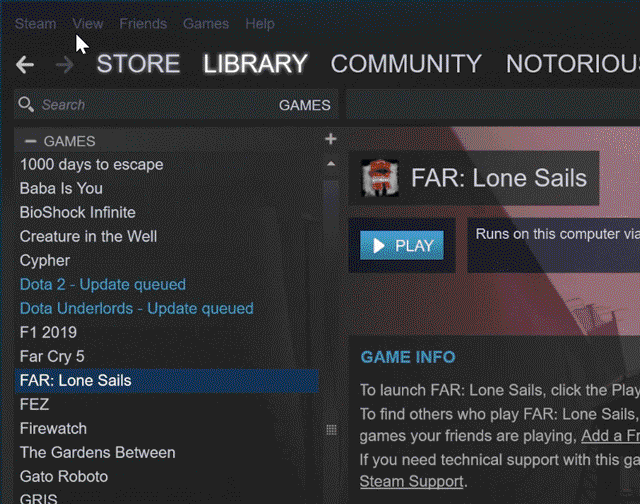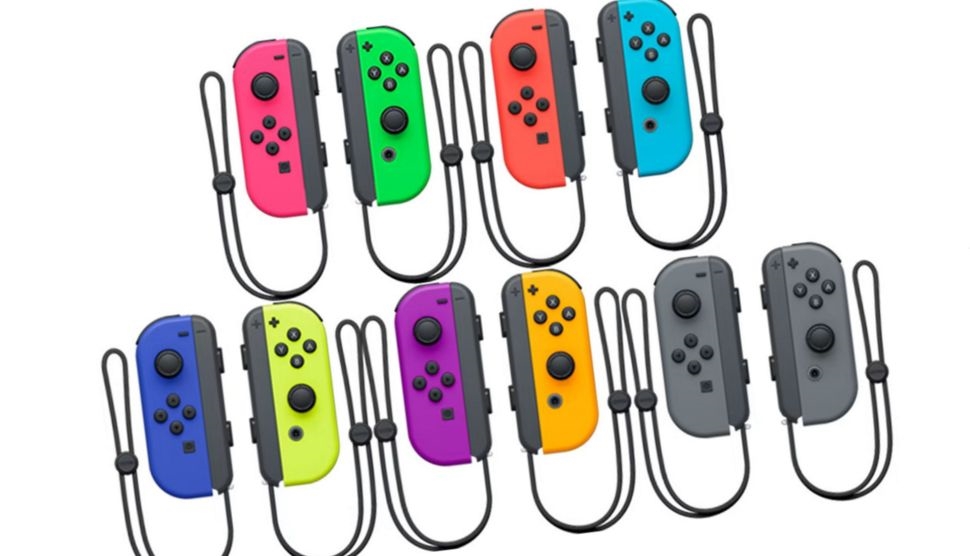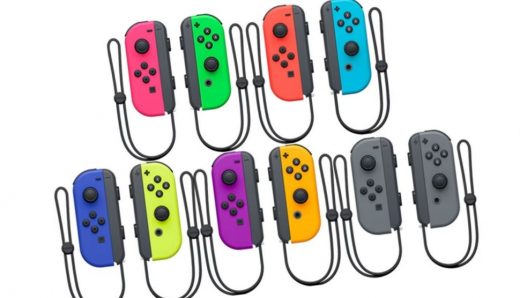Steam is finally adding support for Nintendo Joy-Con controllers
As the Nintendo Switch turns five, a look back at our favorite games
Not the Mario games you’d expect.

Console generations are generally thought to last about half a decade, which is what makes today’s Switch anniversary so momentous. Nintendo’s hybrid home-handheld console turns five today, and it shows no signs of slowing down: Though rumors persist, there’s no announced plans for a new console on the horizon. The most we’ve gotten are two redesigns — the Switch Lite and the OLED Switch — and the expansion of Nintendo Switch Online to include more classic console games. But while it’s certainly fun to revisit old favorites like Super Mario Bros., Kirby’s Adventure and Earthbound, it’s the games made for the Switch that have captured the hearts of the Engadget crew, along with a few other titles that made their debuts elsewhere but really shined on Nintendo’s portable system.
Animal Crossing: New Horizons
Regular Engadget readers know there’s no way I would let a “favorite Switch games” post pass without even one Animal Crossing: New Horizons mention. I’ve been a huge fan since the game launched way back in March 2020, and the big update from last fall really rejuvenated my love for it by introducing a boatload of new features — enough for an entirely new game, if Nintendo has decided to go that route. But no, this was entirely free and new players are sure to get more than their money’s worth as they work through it all.
The game certainly benefited from launching at the start of the pandemic, leaving millions stuck indoors with nothing to do. Animal Crossing’s bright colors and relaxed pace were exactly what people needed in stressful times. But in another reality, would New Horizons still have been a big hit? I’d say yes: The series has always been a big seller and New Horizons was a huge, accessible improvement on previous installments. Once I achieve the basic in-game goals I always tended in drift off in previous Animal Crossing titles, but New Horizons is interesting enough that I still play it regularly two years after its release. — Kris Naudus, Commerce Writer
Fire Emblem: Three Houses
Three Houses is an almost-perfect Fire Emblem game.
I’d been a fan of the series since its English-language debut on the Game Boy Advance, but like many, it was the 3DS games that really made it a firm favorite. 2013’s Awakening was more accessible than anything that came before, softening the sometimes brutal difficulty curve, and expanding the support/ship system in clever ways. Fates in 2016 was a truly massive game that attempted to expand on everything Awakening did, but in doing so made the general experience weaker. There was a sense that the developers had ambitions that just couldn’t be achieved on the 3DS.
Through the 3DS era, there was a growing schism inside the Fire Emblem series where the various mechanics and tones didn’t quite gel. The move to the Switch for Fire Emblem: Three Houses restructures the game for the better. Centering things around “castle life” integrates relationship building, recruitment and battling in a way that just feels natural. And the way the game’s multiple plot paths are handled is so, so, so much better than in Fates.
The battles themselves are probably the area with the most room for improvement. Generally there are only a handful of maps that require you to carefully think about your approach, and the difficulty is only softened by the ability to rewind moves if you mess up. It’s rare that you actually encounter the series’ signature permadeath mechanic, which on one hand means you really love all the characters by the time one of them dies, but on the other takes away a lot of the tension.
But yet, I pumped 215 hours into this game through 2019, driven by the cast of characters and the genuinely divergent story paths you can take. My final playthrough also introduced me to my favorite map in the game — the different paths actually have some genuinely different levels. At this point I think I’ve experienced everything the game has to offer, but after replaying Awakening and Fates during the various coronavirus lockdowns, just writing this has made me realize it’s time to start Three Houses all over again. — Aaron Souppouris, Executive Editor
The Great Ace Attorney Chronicles

Playing DS back in the early 2000s was probably my peak gaming era, not just because I was working at a gaming company (Pokémon) but also because it was around then that I was introduced to various franchises and genres that would become lifetime interests for me. One was Animal Crossing, another was the Ace Attorney series. The DS wasn’t where the series first appeared, but it is where it was first released in the United States. I’ve played every installment since and am now a big fan of visual novels as a genre. However, I was disappointed when I heard the prequel series, Dai Gyakuten Saiban, was unlikely to get an American release due to the difficulty of localization.
Well, until last year when they went and released it anyway as The Great Ace Attorney Chronicles. And, while it doesn’t feature familiar faces and some gameplay techniques introduced in the previous titles, it still has plenty of new tricks and charm to offer both new and returning players. Instead of hiding the game’s Japanese origins, Great Ace Attorney embraces them fully, and the resulting experience is as rich as it is fulfilling. The story somehow has even more twists and turns than previous installments, and I like how everything weaves together into a cohesive whole by the end. I only wish I had time to play it last year so I could have included it among Engadget’s favorite games list of 2021. — K.N.
Hollow Knight
Hollow Knight wasn’t a Switch exclusive, but after spending dozens of hours exploring the murky depths of Hollownest, I’ll always feel like it’s inextricably tied to Nintendo’s handheld. It stands out from the crowded field of Metroidvanias (and the subset with Dark Souls elements), with its elegantly atmospheric aesthetic, gorgeous sprites and a soundtrack that evokes the melancholy of exploring a lost kingdom. It’s tough, but unlike the Souls games, it never feels overtly punishing. (Can’t beat a boss? Try exploring another corner of the map, collect some charms and upgrade your trusty Nail.)
What truly hooked me, though, was being able to take the experience of Hollow Knight anywhere. I played it on my couch when I should have been working, during flights across the world and while I was stuck with a newborn sleeping in my arms (a fun balancing act, for sure). While I could have played Hollow Knight earlier on my computer, or on vastly more powerful systems, the Switch ended up giving me a level of freedom I didn’t know I wanted. — Devindra Hardawar, Senior Reporter
The Legend of Zelda: Breath of the Wild
It’s worth acknowledging that The Legend of Zelda: Breath of the Wild didn’t invent the open world genre. But, it did bring the format to a series that was beginning to get too reliant on its formula of “explore a dungeon, use this item to beat dungeon boss, repeat.” Breath of the Wild instead offers players the ability to explore literally any corner of the world they can see in any order they choose. Even the short intro section on Hyrule’s Great Plateau offers very little in the way of guidance.
Zelda games have always encouraged exploration, despite the linear dungeon-based format, but Breath of the Wild took this to new heights. Hyrule is positively massive, on a scale unlike any prior game in the series, and the lack of traditional guidance means every player will have an entirely different experience with the game. I poured dozens of hours into Breath of the Wild when it came out and eventually beat the game’s main goal, but I’ve gone back to it on and off in the years since to keep finding more dungeons and challenges. I don’t think I’ll ever be done exploring this exquisitely rendered version of Hyrule. — Nathan Ingraham, Deputy Editor
Metroid Dread
Metroid Dread faced a tall order when it launched in late 2021. It was the first all-new Metroid game since 2010’s disappointing Metroid: Other M, and the first new mainline, side-scrolling game in the series since Metroid Fusion way back in 2002. Fortunately for Metroid fans, Nintendo pulled it off. Dread works just as well whether you’ve played all of Samus Aran’s earlier adventures or if it’s your first time giving the series a shot.
Developer MercurySteam kept the familiar Metroid loop of exploration that leads to new weapons that opens up new areas that were previously inaccessible, but it also added a major stealth element this time out. Some areas you explore are populated by an E.M.M.I. robot that you’ll need to avoid until you find the appropriate power-up to defeat it, and those robots can kill you in one hit. So sneaking around is key, but the game mercifully gives you plenty of opportunities to retreat to safe ground and reconsider your strategy. It adds a whole new wrinkle to Metroid Dread — but the game’s focus isn’t solely on stealth. There are plenty of monsters to battle, caverns to explore and huge bosses to take down. It’s the complete Metroid package, whether you’re new to the series or not. — N.I.
New Super Mario Bros. U Deluxe
Super Mario Odyssey may be the Mario title that got the most attention in the last five years — but don’t sleep on the awkwardly titled New Super Mario Bros. U Deluxe. If, like me, you grew up worshiping at the altar of Super Mario World, U Deluxe is the best side-scrolling Mario game Nintendo has released in decades. It’s right up there with all-time greats World and Super Mario Bros. 3.
The game was originally released for the Wii U, a system that got no traction in sales, so plenty of Switch owners had never experienced its joys when the game was released in 2019. And, while it’ll feel familiar if you’ve played any side-scrolling Mario game before, the level designs are fresh, the challenges are just the right amount of hard and the world looks just gorgeous. It doesn’t exactly break new ground, but New Super Mario Bros. U Deluxe shows that the original Mario format still has a place in 2022. — N.I.
Sayonara Wild Hearts
Sayonara Wild Hearts was once described as “Give Carly Rae Jepsen a Sword: the Game.” If that alone doesn’t sell you on this gem, I don’t know what will. It’s an ultra-stylish fever dream of an arcade game tied to a killer pop soundtrack.
It should take just over an hour to propel through the 23 levels, which are packed with slick visuals and clever gameplay ideas that’ll keep you on your toes. There’s so much to take in that, if you’re anything like me, you’ll replay the whole thing at least a few times over (especially if you want to complete the Zodiac Riddle objectives).
There are some tricky sections, but Sayonara Wild Hearts is a forgiving game with a ton of checkpoints and an option to skip parts you might struggle with. The developers are determined to help you reach the emotional finale and find out whether the protagonist can repair her broken heart. It’s absolutely a worthwhile journey. — Kris Holt, Contributing Reporter
Super Mario Maker 2
Super Mario Maker 2 did what Breath of the Wild couldn’t. It convinced me to buy a Switch. As a lifelong Mario fan who didn’t buy a Wii U to play the original Super Mario Maker, I wasn’t going to miss out this time around.
I love knowing that, at any moment, I can pick up my Switch and play a Mario level I’ve never seen before. I might even be the first person (other than the creator) to try it. Sure, there are a ton of garbage stages filled with too many Bowsers, but it doesn’t usually take long before I play one that puts a smile on my face.
I’ve dabbled in making levels, though there’s only one I liked enough to share. It’s a puzzle stage inspired by, of all things Marie Kondo. That’s kind of fitting, given how many times Super Mario Maker 2 has sparked joy for me. — K.H.
Stardew Valley
Of all the Switch games I’ve played, Stardew Valley is one of the very few that I continuously go back to — particularly when I need some “me” time. Growing up, I spent a lot of time playing games like Harvest Moon: A Wonderful Life, so Stardew fills that hole for me now as an adult. I love the repetitive humdrum of building my farm up from nothing, cultivating a pleasant little green space where my character and all their chickens, rabbits, cows and goats can flourish. Harvesting pumpkins, strawberries and corn has never been more satisfying, and I’m always eager for the change of seasons when I can kick the dirt up on all of my plots and start fresh with a plethora of new veggie and fruit seeds.
There are a ton of side storylines and quests to complete, and I love that I can do them on my own time, or not at all. Maybe I spent too much time tending to my cows and sheep and missed the deadline to deliver a bunch of leeks to Evelyn. It’s OK, she won’t hold it against me… too much. And when I feel the urge to get a little dangerous, there are plenty of mine levels to explore with treasure to discover, monsters to defeat and prismatic shards to desperately search for. However, Stardew doesn’t have the highest of stakes, and sometimes I’m in the mood for tougher battles and the possibility of death (preferably by Lynels). But nothing beats going back to the farm that you built from scratch and picking up where you left off once again. After all, there’s always something more to do. — Valentina Palladino, Commerce Editor
(70)


